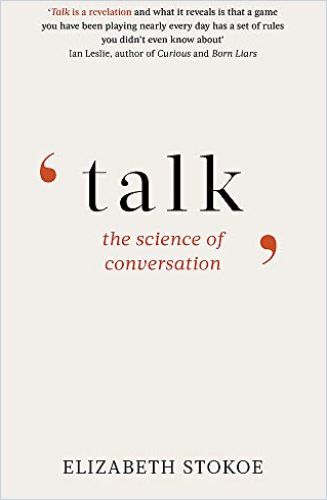Social psychologist Elizabeth Stokoe provides a fascinating – and yet practical – exploration of the systems underlying conversational patterns and how you can apply them to improve your verbal communications.

When You Speak
Social psychologist and conversation analyst Elizabeth Stokoe discusses the “science of conversation.” Studying conversations enables understanding of how highly organized underlying systems structure human talk, and of how different ways of speaking can alter outcomes. Stokoe avoids conventional communication training, debunks popular myths and provides new and surprising revelations.
Real-Life Conversations
The pioneers of conversation analysis – Harvey Sacks, Emanuel Schegloff and Gail Jefferson – studied how changing a single word affects a conversation. Their analyses noted how speakers take turns. For example, the opening sequence of a typical conversation generally contains brief, reciprocal paired actions that include “summons and answer,” “greetings and identifications,” and “initial inquiries.” Humans process conversations quickly and respond, enabling rapid exchanges in which overlaps are common.
All humans are subconscious conversation analysts, says Stokoe. You constantly assess what people say and how they say it. You are adept at knowing when it is your turn to speak, when you’ve misspoken, or when someone is being hypocritical or disingenuous. Conversation has tacit rules, which is why it can be so jarring when someone breaches those rules and speaks out of turn or in an unexpected way.
Unaligned Conversations
Stokoe notes that conversations in which the participants aren’t in alignment follow a different pattern than that of friendly exchanges. The science of conversation analysis allows researchers to pinpoint moments of trouble and predict outcomes.
Analyzing real talk in the wild – and in slow motion – shows us the incredible power talk has to shape our daily lives.Elizabeth Stokoe
Analyses of sales calls, negotiations, police interrogations or conversations between doctors and patients, for example, reveal that words, phrases, inflections, gaps and pauses strongly influence a conversation’s outcome. Comparing successful exchanges to those that fall short allows analysts to identify which words, turns and patterns produce desired results.
Take Turns
Communication fuels social activity. People take turns communicating, choosing words from an array of possibilities to build into units such as sentences. They monitor one another’s turns to assess when they should speak and what might be appropriate to say. Humans have an innate ability to understand paralinguistic subtleties, such as tone, pacing and inflection.
Talk is simultaneously simple and complex. It is messy – full of ums, uhs, false starts, pauses – but remarkably systematic.Elizabeth Stokoe
The relationship between participants shapes the nature of turns. For example, your long-time partner might simply say, “Cinema?” to invite you to a movie, to which you might reply, “OK.” People who don’t know each other intimately might begin with a “pre-invitation,” such as, “What are you doing tonight?” and a more complex conversation ensues. Oftentimes, turns overlap. Some interruptions are violations or power plays, while others are friendly collaborations.
True Natures
People’s turns of talk reveal their characters. “First movers,” for example, issue a challenge or make unprovoked or out-of-place conversational turns. “Mis-greeters” return a greeting, but their eyes search for someone more important to talk to. “Recalibrators” are mis-greeters until they decide you are important. They then return your greeting with their – perhaps insincere – attention. “Non-questioners” ignore tacit greeting rules to hijack the conversation and talk about themselves. “Passive-aggressives” take an aggressive first turn and a defensive third turn. “Recruiters” place the mental load of remembering or fulfilling a task on others. The “recruited” anticipate and help other people before someone asks them for assistance.
Body Language
The idea that actions speak louder than words is a myth, says Stokoe, as is the notion that body language and nonverbal behaviors make up 93% of communication, though humans do monitor words, facial expressions, gestures and body language when trying to discern meaning. A word or gesture in one context may mean something entirely different in another. Thus, meaning is often complex, ambiguous and elusive.
Actions do not speak louder than words. Words are actions. No talk is ‘small’; talk does big things.Elizabeth Stokoe
Popular psychology and self-help books propagate the notion that gender plays a role in communication. Science doesn’t support this supposition. For example, studies showing that men interrupt more than women frequently derive from incorrect assumptions about interruption. Sometimes an interruption is in fact a turn overlap or a cooperative affirmation.
Words Matter
During conversations, people self-edit; that is, they substitute, fix and replace words to convey what they mean and to give a certain impression of themselves. One study revealed how changing one word in conversations between doctors and patients produced a statistically significant change. Instead of asking, “Is there anything else you would like to discuss today?” which seldom elicited a response, doctors asked, “Is there some other issue you’d like us to address during this visit?” Substituting “some” for “any” drew a much higher response.
Implicit Rules
People design requests according to implicit rules. The words they use differ, depending on how urgently they need help and whether they feel entitled to it. Beginning an exchange with, “Is it possible?” signals uncertainty. Asking, “Would you?” implies entitlement. Saying “need” instead of “want” denotes urgency.
The problem with ‘building rapport’ is that it is oxymoronic. If you have to try to build rapport, you are probably very visible in your doing of it.Elizabeth Stokoe
Trying to build rapport comes across as disingenuous. Listen intently to your conversation partner. Use summarizing, mirroring or paraphrasing to ensure you’re tuned in. Forget the myths about using body language, and let the science of conversation analysis guide you.
Fascinating Insights
Stokoe writes with enthusiasm and never devolves into scientific language or jargon; her fascinating, compassionate work appeals to a general audience. Each page brings a revelation that explains speech patterns. In identifying and explaining those patterns, Stokoe holds a mirror up to every reader, and aha! moments abound. She provides sound guidance for more balanced, productive conversations.
Conversation analyst Elizabeth Stokoe co-wrote Conversation and Gender and Discursive Psychology.





